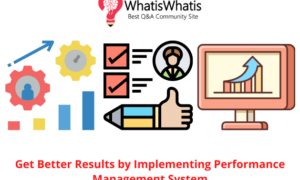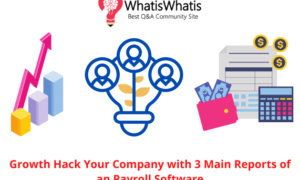The HR department plays a crucial role in developing and changing the culture of an organization. We can say that the personnel department of the firm is the engine of the business’s train, which helps other departments to reach the predicted destination, i.e., goal achievement.
Earlier, the work of HRD was just limited up to the hire and fire of the staff, but nowadays, they are giving their attention to employee’s satisfaction, retention, performance management, leave and attendance management, and making strategic decisions that affect the workforce of the company.
Read more: Everything you need to Know about IT Consulting- Definition, Types, Benefits, Cost
The HR department prepares the strategic HRM plan that gears up the business from its current position. It handles the workforce in the working premises as well as looks over the productivity of the employees and workforce retention, which affects the profitability of the firm.
In short, the size of the organization doesn’t matter when it comes to the presence of the personnel department. Below, you can read the important HR challenges for the growth of Small and medium-sized enterprises (SMEs).
What are the primary HR challenges that hinder the growth of SMEs?
If you want to keep your business running smoothly, you must hire the best personnel manager who will later help the business to pick the best candidate from the talent pool.
But according to the study, small and medium-sized businesses are more or less facing HR-related challenges, which affects the growth of the small firm. At the same time, the giant company already starts investing in the human resource department, which is why they grow faster than the SMEs.
Statutory Compliance
Statutory compliance means a legal rule and regulation in the business adherence means laws and statutes related to the employees for HR Challenges.
Controlling the workforce’s activity in the working premises is essential to protect the rules and by-laws of the firm in a way that employees don’t dislike the workplace and don’t feel much rigidity in it. Even each organization may not follow the same governance of labor laws, which distract employees.
Solution
Each organization must follow adherence mentioned in Indian labor laws. Especially they need to follow the rules of the minimum wages act.
Hiring The Best Talent
Generally, SMEs lack in the recruitment process as they don’t have sufficient funds for the same. A recruitment campaign is not just a child’s play; it needs both time and cost. If we assume that they have enough time for the hiring process, then also they are not sure that the person they hire is trustable or not? That is why they also face issues of employee turnover in HR challenges.
Solution
SMEs needs to follow the step-by-step recruitment process, which is as follows;
- Identify the vacancy or needs of hiring
- Prepare job description
- Search for talent
- Screening and shortlisting the eligible resume
- Personal Interview and personality/skill test
- Provide an offer letter to the applicant (After discussing the rules of the firm)
- Onboarding
These are the steps of an effective hiring process that they need to follow. Moreover, they need to prepare the question list that they should ask the candidate.
They just need to add behavioral-based questions to ensure that the applicant is the best fit for the culture of the company. Even they need to verify the experience letter of the employee as well as the educational degree they have; sometimes, candidates submit fake documents that affect the firm badly.
Lack Of Technological Tools
SMEs don’t know about technological advancement; they don’t even invest more in automated tools. At the initial stage, it is not compulsory to adopt a fully automated workplace, but at least they need to implement technological tools that simplify essential business operations like recruitment, employee attendance, tools to control remote employees, etc. But as they lack funds, they might not be able to invest in technological devices. Management tools are playing very important role in HR challenges.
Solution
As we discussed above, they need to implement at least basic technological tools that simplify basic operations, that is, human resource management solution. Did you know about the manual method and its cons? Of course, yes! Because it has not even a single advantage.
An essential thing for the business at its initial stage is data security and safety. Did you think that pen-paper work assures protection of the data? Then it is essential for the SMEs to implement cloud-based automated tools at the beginning stage to keep employee-related data, business strategies, and other important files safe.
Retaining Employees
Small and medium businesses face difficulties in keeping the employees for a longer period. Because they are not able to give an effective working environment to the employees, that is why it increases the employee dissatisfaction ratio, which ultimately decreases the employee retention rate.
Solution
Following are the ways to retain the workforce for a longer period;
- Offer them a competitive salary
- Investing in employees development and training
- By creating two-way communication culture
- Be transparent with the employees
- Offer them tempting perks and benefits
- Flexibility in the workplace is the key factor in employee retention
- Do what increases their happiness and satisfaction
There are so many other policies/activities that increase the retention ratio of staff; they should follow the same. Moreover, at the time of training and onboarding, they need to follow the four C’s, i.e., compliance (transparency in rules and regulations), clarification (well-explained role and duties), culture (working pattern), and connection (relationship with others).
HR Challenges: Training Of Workforce
Business training gives in-depth knowledge to the newly joined employees about his/her role and responsibility and the skills they need while performing the duty in the working premises.
The employee who just joined the organization doesn’t know the culture and the working environment, so to make them comfortable in the workplace, employers provide basic training to them before onboarding. But SMEs don’t give sufficient time to the new employees and do not effectively explain about the company, its products, mission, vision, and goal, etc., which is not at all acceptable.
Solution
Employers of the organization, as well as the manager, need to create an effective training plan for each new employee. Not even for new employees, they need to provide retraining or advance training to the existing employees. Following are the steps for conducting retraining session in an organization;
- Assess the needs of training
- Set the goal for the same
- Create an action plan for training
- Implement training initiative and explain its importance to the employees
- Check the effectiveness of the program
Conflicts Within Working Premises
Conflicts between employees-employers and employee-employee are expected because we all know that each individual has a different state of mind and thinking ability. But conflict resolution is essential; otherwise, it affects the working environment terribly.
Solution
Firstly, the HR manager needs to identify the real issue, after that he must listen to the point of view of both parties, after that he can list out the possible resolution tactics, then nextly he must evaluate each option and select the best among all, the next step is implementing the same in a way that both the parties satisfied with the outcomes. The whole process should be without biasness.
Employee’s Resistance To Change
Change in rigid processes is necessary, but at the initial stage, mostly employees resist change due to a lack of effective change management techniques.
Employees do not accept the change, or we can say adaptation of technological tools due to lack of education, but it is a duty of the employer to assist them for the same because ultimately, the change simplifies their workload only.
See more: What are the tasks and roles of management or managers
Solution
Change adoption is a vast process, following are the steps for the same;
- Identification of what will be in need to improve
- Make an actionable plan to convince the stakeholders
- Create a plan for the change
- Explain the pros of new adoption
- Allow open communication so that employees can clarify their doubts
- Implement and analyze the newly implemented change
- Prepare insights for the same and change the plan if needed
These are the steps which are necessary to follow while implementing new change in the working premises.
Employee’s Diversity And Inclusion
Diversity in the working premises means the workforce has a different mindset, working experience, religion, ethnicity, languages, age, educational qualification, etc.
The HRD intentionally recruits a diverse workforce to get the benefit from the same. Inclusion means all the employees must be treated the same by the employers. Employers lack employee diversity and inclusion, which increases conflicts in the workplace that affects the productivity of the employees.
Solution
One of the key solutions of managing diversity and inclusion is by opening the door of two-way communication. Moreover, in a diverse workplace, employers need to treat each employee individually, which motivates them to work as an effective diverse team.
Compensation Of Staff
Basically, due to lack of funds and its management, SMEs face issues related to the compensation of the workers, while large businesses use their deep pockets as a competitive advantage.
Solution
Small businesses need to implement a compensation strategy to retain the staff for the long term. It is necessary to provide compensation to them for their performance.
Employee Productivity in HR Challenges
Because of workplace conflict, lower employee engagement, inadequate employee training, SMEs face issues related to workforce productivity.
Solution
Employers need to analyze the performance of the employees after the end of the month and prepare insights for the same and accordingly need to arrange training sessions, guest talk, or doubt solving sessions for the employees which increases their productivity.
Employee’s Benefits
SMEs lack when it comes to employee satisfaction and their happiness; they are lacking in preparing handbooks of employee benefit, etc., which decreases employee retention rate.
Solution
It is not necessary to provide them only monetary-based benefits; non-monetary rewards also motivate them and increases their productivity.
Lacking In Management
The important thing to run the business effectively is management. SMEs lack in managing the workers in the premises, which invites conflicts in the workplace that affects the performance of the staff members.
Solution
By building trust, enhancing leadership skills, implementing a flexible working schedule, controlling the workforce’s activity, etc., the manager can implement effective management tactics.
Read more: Growth Hack Your Company with 3 Main Reports of an Payroll Software
The Bottom Line
SMEs need to hire an HR manager who just not orders a coffee but effectively handles the workforce and other strategic operations, which affects the goodwill and the profitability of the firm. I hope these HR Challenges will helpful for your company growth.






Leave a comment